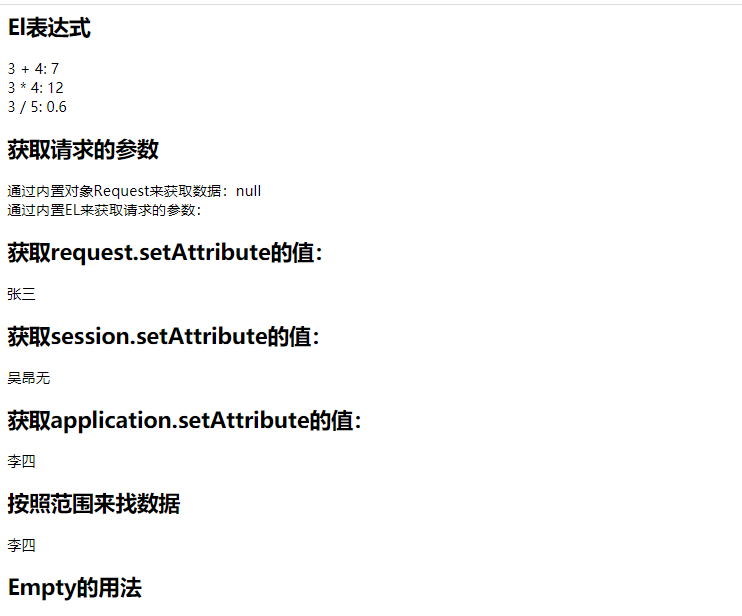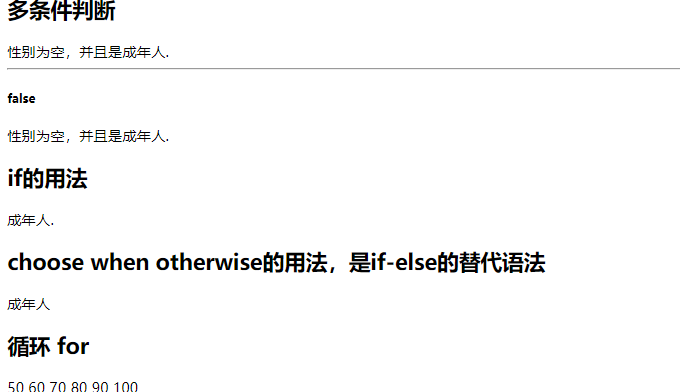El(Expression Language),全称表达式语言,目的是尽量的消除JSP页面中的java代码,其方法如下:
1 <% 2 request.setAttribute("name", "张三"); 3 session.setAttribute("name", "田奇"); 4 session.setAttribute("username", "吴昂无"); 5 application.setAttribute("name", "李四"); 6 request.setAttribute("gender", ""); 7 %> 8 9 <h2>El表达式</h2> 10 3 + 4: ${3 + 4} <br> 11 3 * 4: ${3 * 4} <br> 12 3 / 5: ${3 / 5} <br> 13 14 <h2>获取请求的参数</h2> 15 通过内置对象Request来获取数据:<%=request.getParameter("username") %> <br> 16 通过内置EL来获取请求的参数:${param.username} <br> 17 18 <h2>获取request.setAttribute的值:</h2> 19 <!-- requestScope是固定写法, name是其他位置 request.setAttribute() 的key, --> 20 ${requestScope.name } <br> <%-- 相当于 <%=request.getAttribute("name")%> --%> 21 22 <h2>获取session.setAttribute的值:</h2> 23 <!-- sessionScope是固定写法, username是其他位置 session.setAttribute() 的key, --> 24 ${sessionScope.username} <%-- 相当于 <%=session.getAttribute("username")%> --%> 25 26 <h2>获取application.setAttribute的值:</h2> 27 <!-- applicationScope是固定写法, name是其他位置 application.setAttribute() 的key, --> 28 ${applicationScope.name} <%-- 相当于 <%=application.getAttribute("name")%> --%> 29 30 <h2>按照范围来找数据</h2> 31 <%-- 32 如果直接写值,会按照reqeust -> sesssion -> application这个层级来找。 33 在实际的应用中,强烈建议把requestScope、sessionScope、applicationScope带着,因为方便代码的维护。 34 --%> 35 ${applicationScope.name} 36 37 <h2>Empty的用法</h2> 38 <!-- 判断一个数据是否为null, 或者一个字符串为空或"" --> 39 ${empty requestScope.gender} <br> 40 <!-- empty可以用于三元表达式 --> 41 ${empty requestScope.gender ? "默认值" : requestScope.gender} 42 43 <h2>gt、ge、lt、le、eq</h2> 44 5 > 3: ${5 > 3} <br> 45 5 > 3: ${5 gt 3} <br> <%-- greater than --%> 46 14 < 3: ${14 < 3} <br> 47 14 < 3: ${14 lt 3} <br> <%-- less than --%> 48 14 >= 3: ${14 ge 3} <br> <%-- greater or equals --%> 49 14 <= 3: ${14 le 3} <br> <%-- less or equals --%> 50 14 == 3: ${14 eq 3} <br> <%-- equals --%>

JSTL(jsp standard tag library)全称为"标准标签库",使用一套标准的标签库,来极大的简化代码的编写,必须要配置EL来使用
1) 引入javax.servlet.jsp.jstl.jar和jstl-impl.jar两个jar包
2) 在jsp页面的头顶加上标准标签库指令
1 --%> 2 <%@ page contentType="text/html;charset=UTF-8" language="java" %> 3 <!-- 标签库指令 4 prefix 前缀, 表示jstl的标签的前缀,可以使用任何的字母(一个或多个都可以) 5 但是大家都写c, 所以我们也写c 6 suffix 后缀 7 --> 8 <%--标签库指令--%> 9 <%@ taglib uri="http://java.sun.com/jsp/jstl/core" prefix="c" %> 10 <html> 11 <head> 12 <title>Title</title> 13 </head> 14 <body> 15 <% 16 request.setAttribute("age", 20); 17 request.setAttribute("gender", null); 18 %> 19 <h2>多条件判断</h2> 20 <c:if test="${empty requestScope.gender && requestScope.age gt 18}"> 21 性别为空,并且是成年人. 22 </c:if> 23 <hr> 24 <!-- 25 requestScope.gender为空值的问题?????? 26 --> 27 <h5>${requestScope.gender == ''}</h5> 28 <!-- 透过tomcat源码部分,判断requestScope.gender如果是一个null, 29 就直接返回一个false, equals判断不做了,也就是为什么抛出空指针异常的问题。 30 31 在实际的工作中,我们通过一个字符串是否为 null, 或者 "", 均通过empty来判断。 32 --> 33 <c:if test="${!requestScope.gender.equals('') && requestScope.age gt 18}"> 34 性别为空,并且是成年人. 35 </c:if> 36 37 <h2>if的用法</h2> 38 <!-- 39 if是否成立,要根据test中的返回结果,但是test必须是EL. 40 jstl中,只有if,没有else. 41 --> 42 <c:if test="${requestScope.age gt 18}"> 43 成年人. 44 </c:if> 45 46 <h2>choose when otherwise的用法,是if-else的替代语法</h2> 47 <!-- 48 有点类似于switch() case . 49 --> 50 <c:choose> 51 <c:when test="${requestScope.age > 40}"> 52 中年人 53 </c:when> 54 <c:when test="${requestScope.age > 30}"> 55 壮年 56 </c:when> 57 <c:when test="${requestScope.age > 18}"> 58 成年人 59 </c:when> 60 <c:otherwise> <!-- 否则 --> 61 小青年 62 </c:otherwise> 63 </c:choose> 64 65 <h2>循环 for</h2> 66 <%-- 67 for(int i = 50; i <= 100; i+=10) { 68 69 } 70 --%> 71 <%-- 72 begin是开始的值; 73 end是结束; 74 var是定义的变量名. 75 step是步进的意思,就是每次加多少 76 --%> 77 <c:forEach var="i" step="10" begin="50" end="100"> 78 ${i} 79 </c:forEach>
